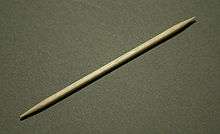Toothpick


A toothpick is a small stick of wood, plastic, bamboo, metal, bone or other substance used to remove detritus from the teeth, usually after a meal. A toothpick usually has one or two sharp ends to insert between teeth. They can come in both wood and plastic, and can also be used for picking up small appetizers (like cheese cubes or olives) or as a cocktail stick.
American wooden toothpicks are cut from birch wood or made from plastic. Logs are first spiral cut into thin sheets, which are then cut, chopped, milled and bleached (to lighten) into the individual toothpicks.[1] Maine used to be the leading producer of toothpicks for the United States. The last wood toothpick plant in Maine closed in 2003.[2] Plastic toothpicks, also called dental pics are still made in America in Georgia, by Armond's Manufacturing. The Mayo Clinic recommends using a dental pic in lieu of a wooden toothpick to clean your teeth, as they clean more effectively and you do not risk injuring your gums.
History
The toothpick is known to predate the arrival of early modern humans. It is the oldest instrument for dental cleaning. The skulls of Neanderthals, as well as Homo sapiens, have shown clear signs of having teeth that were picked with a tool.
In 1986, researchers in Florida discovered the 7500-year-old remains of ancient Native Americans and discovered small grooves between many of the molar teeth.[3] One of the researchers, David Dickel of Florida State University, said "The enamel on teeth is quite tough, so they must have used the probes quite rigorously to make the grooves."[3]
Toothpicks are well known in all cultures. Before the toothbrush was invented, teeth were cleaned with hard and soft dental woods. Toothpicks made of bronze have been found as burial objects in prehistoric graves in Northern Italy and in the East Alps. The use of toothpicks was also well known in Mesopotamia.
There are delicate, artistic examples made of silver in antiquity, as well as from mastic wood with the Romans.
In the 17th century, toothpicks were luxury objects similar to jewelry items. They were formed from precious metal and set with expensive stones. Frequently they were artistically stylized and enameled.
The first toothpick-manufacturing machine was developed in 1869, by Marc Signorello. Another was patented in 1872, by Silas Noble and J. P. Cooley.[4]
Nowadays other means of dental hygiene are preferred such as dental floss and toothbrushes.
Toothpicks are also used for festive occasions, and are commonly used to spear appetizers. Often, these toothpicks are decorated with plastic frills or small paper umbrellas or flags.[5]
In September 2012 a world record was set in Ireland for the most toothpicks in a beard. 3,107 toothpicks were placed in Ed Cahill's beard in just under three hours.[6]
See also
| Wikimedia Commons has media related to toothpicks. |
References
- ↑ How It's Made: "Toothpicks; acrylic bathtubs; helicopters; beer." The Discovery Channel.
- ↑ "Maine's Last Toothpick Rolls Off Line, Plant Closes." As Maine Goes. N.p., n.d. Web. 23 Nov. 2012. <http://www.asmainegoes.com/content/maines-last-toothpick-rolls-line-plant-closes>.
- 1 2 (AP) (06/22/1986). "Dentistry as practiced 5510 B.C.". Toronto Star.
- ↑ Mary Bellis. "History of the Toothbrush and Toothpaste". About.com Money.
- ↑ "The Marketing Genius Who Brought Us the Toothpick." Slate Magazine. N.p., n.d. Web. 23 Nov. 2012. <http://www.slate.com/articles/business_and_tech/design/2007/10/stick_figure.single.html>.
- ↑ Glenday, Craig (2014). Guinness Book Of World Records 2014. p. 111. ISBN 9781908843159.
Further reading
- Petroski, Henry (2007-10-16). The Toothpick: Technology and Culture. Knopf. ISBN 978-0-307-26636-1.
External links
| Look up toothpick in Wiktionary, the free dictionary. |
- Video - how toothpicks are manufactured
- http://www.armonds.com/ American Made Dental Picks/Toothpicks